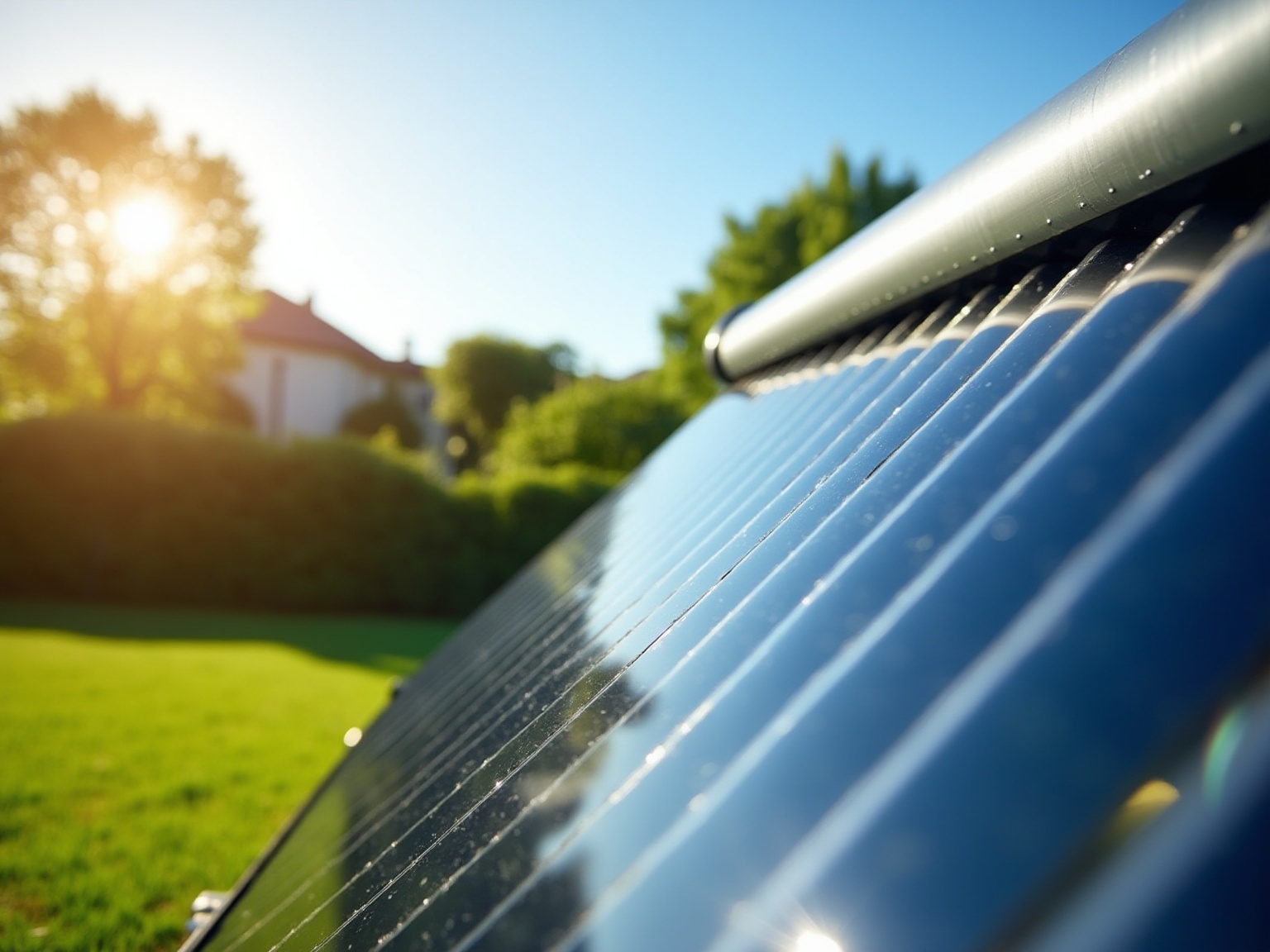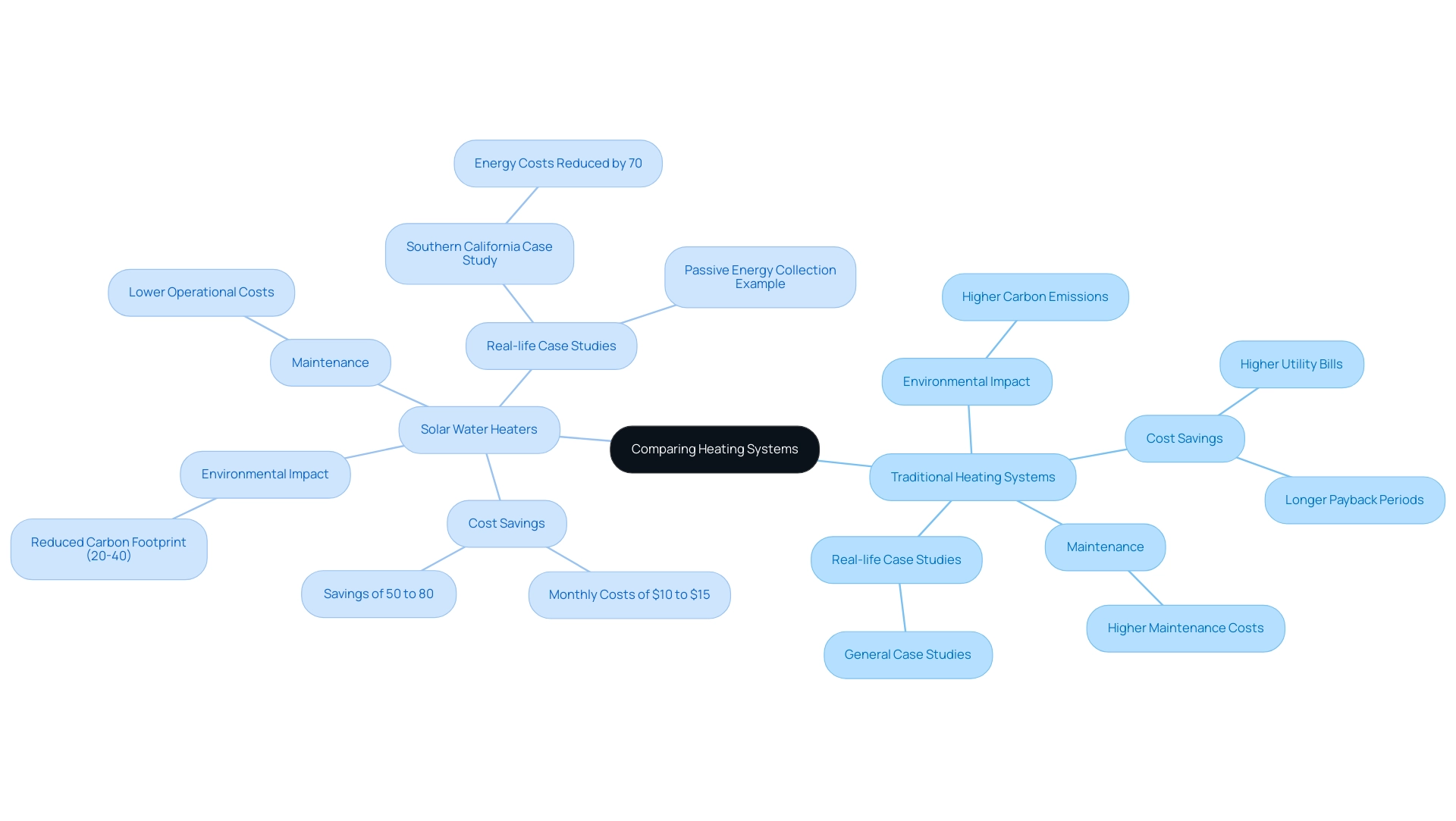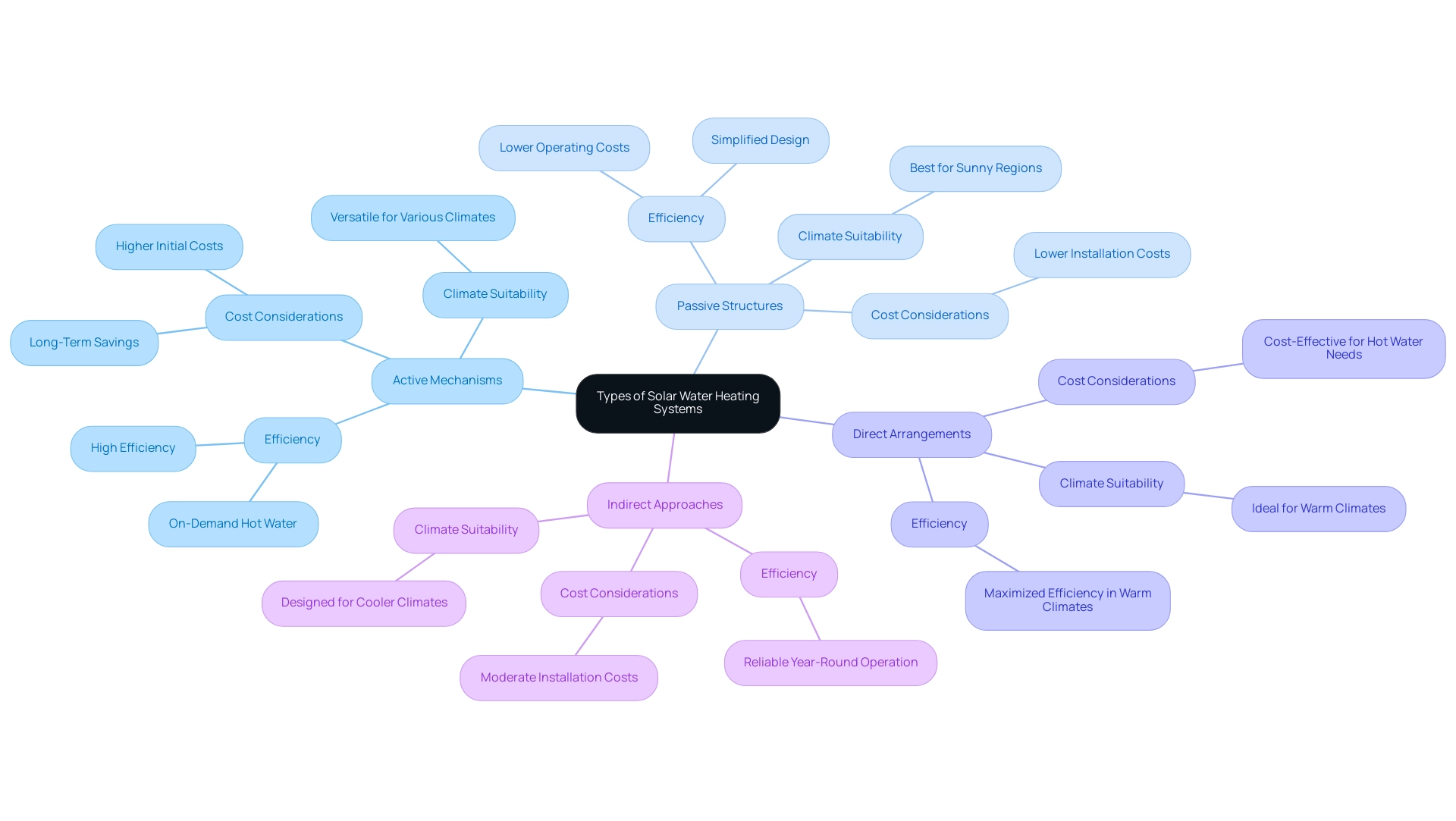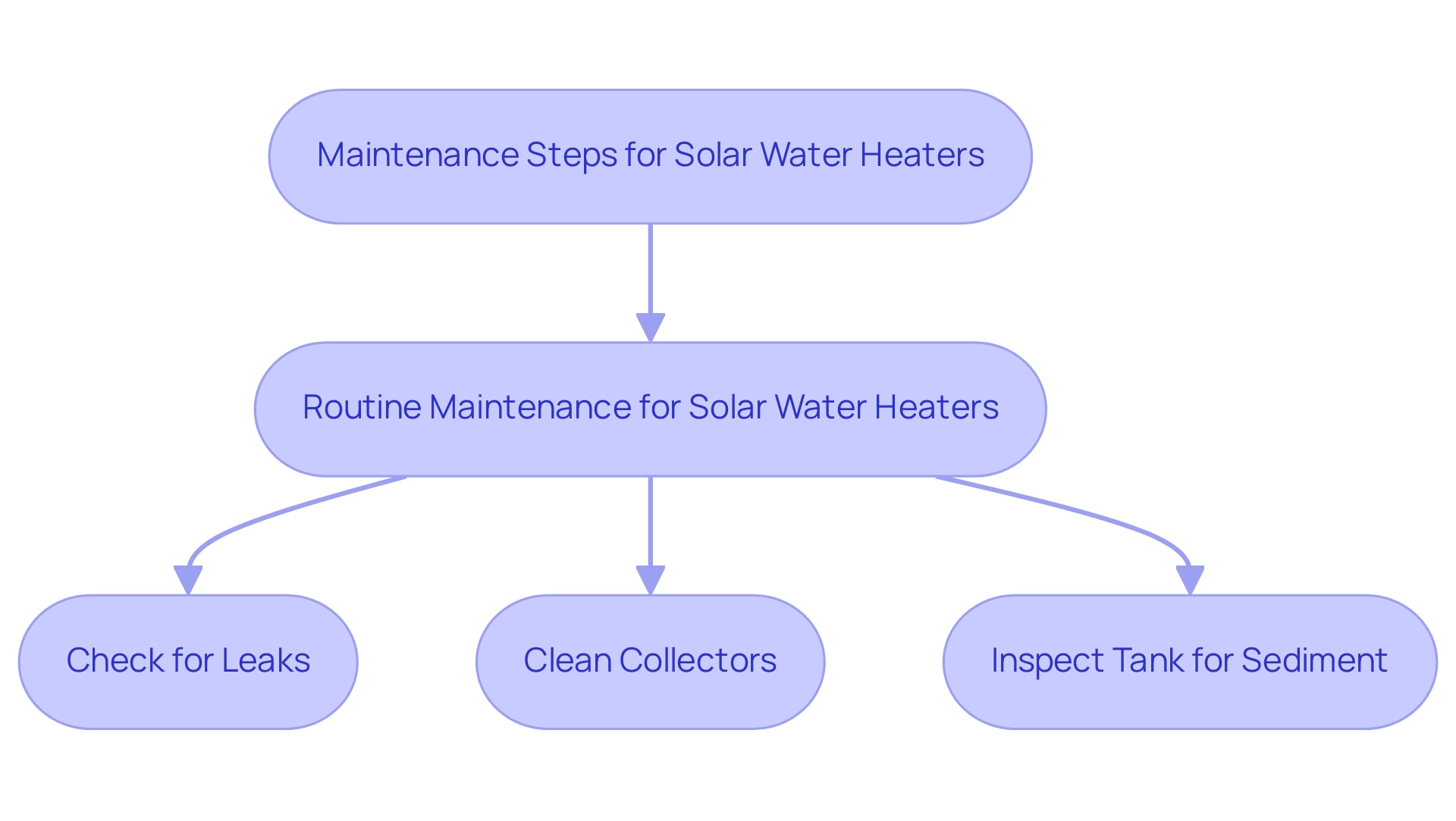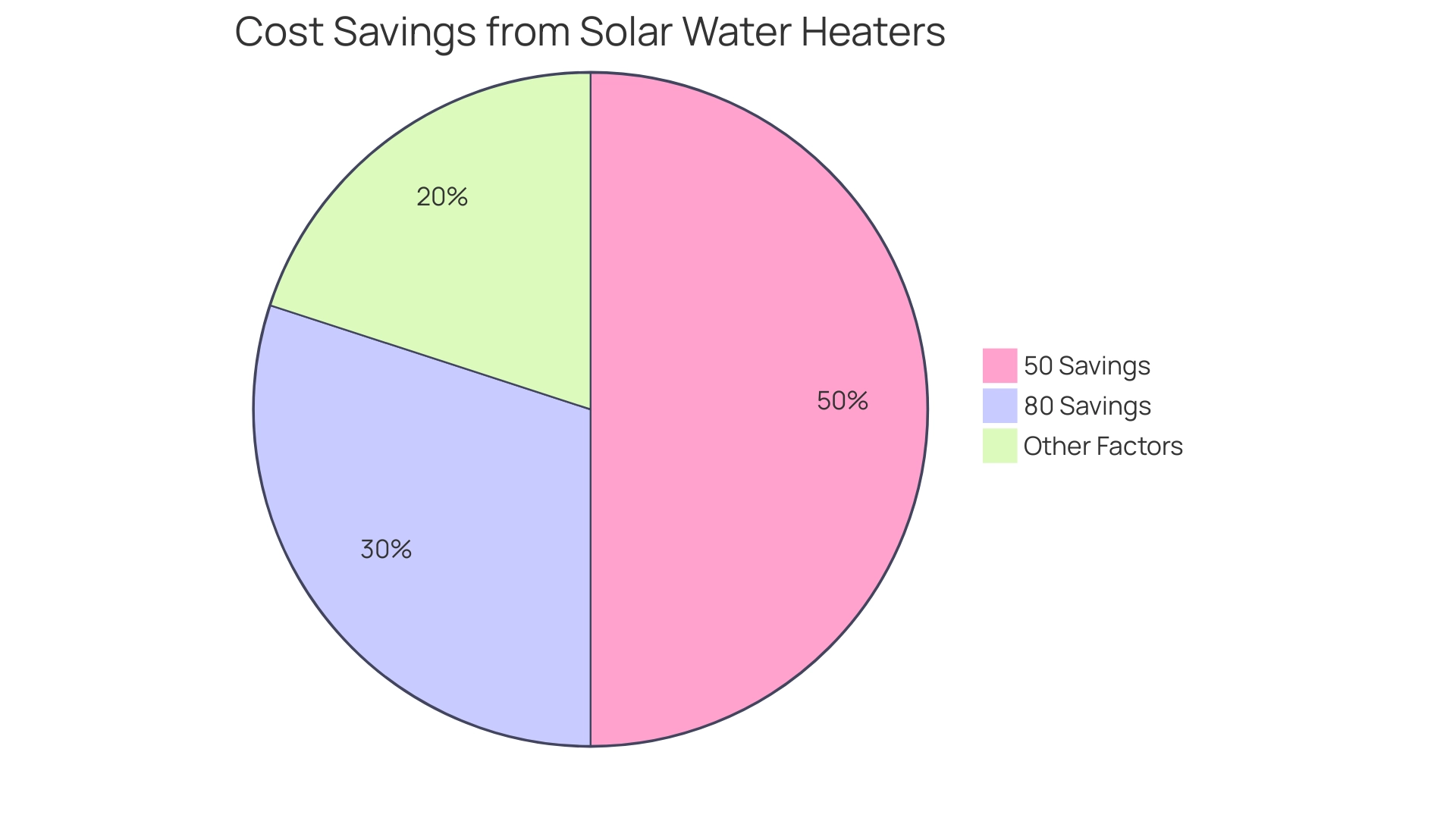Overview
We understand that rising energy bills can be a source of stress for many homeowners. The role of a solar water heater tank is to provide an eco-friendly and cost-effective solution for heating water by harnessing solar energy. This not only significantly reduces utility bills—potentially saving you between 50% to 80% on heating costs—but also contributes to environmental sustainability. By reducing reliance on fossil fuels and lowering greenhouse gas emissions, you are taking a meaningful step towards energy independence.
Imagine the peace of mind that comes with knowing you are making a positive impact on both your finances and the planet. Together, we can embrace these sustainable solutions that benefit our homes and our environment. If you’re ready to explore how a solar water heater can transform your energy habits, we’re here to support and guide you every step of the way.
Introduction
In a world that is increasingly aware of the need for sustainable energy solutions, we understand that many homeowners are concerned about rising energy bills. Solar water heaters are emerging as a game-changer for eco-conscious individuals seeking a more affordable and environmentally friendly option. These innovative systems harness the sun’s abundant energy to heat water efficiently, offering a cleaner, greener alternative to traditional fossil fuel-based heating methods.
With the potential to slash utility bills by up to 80% and significantly reduce greenhouse gas emissions, solar water heaters not only promise substantial savings but also contribute to a healthier planet.
It’s common to feel overwhelmed by the choices available, but as advancements in technology make these systems more accessible and efficient, understanding the various types, benefits, and installation processes of solar water heaters becomes essential.
Together, we can make a positive impact on our energy consumption and environmental footprint, ensuring a brighter future for all.
Understanding Solar Water Heaters: An Eco-Friendly Solution
Are you feeling overwhelmed by rising energy bills? You’re not alone. Many homeowners share your concerns, and it’s natural to seek solutions that not only ease financial burdens but also contribute to a healthier planet. Enter solar water heater tanks—devices thoughtfully designed to warm domestic hot liquids by harnessing the sun’s energy. These eco-friendly systems present an alternative to traditional heating methods that typically depend on fossil fuels, helping to reduce greenhouse gas emissions and promote a more sustainable future.
In sunny California, where sunlight is abundant, these systems operate efficiently throughout the year, ensuring you enjoy a consistent supply of hot water while minimizing your carbon footprint. The growing trend of solar heating systems is encouraging; recent statistics indicate an increasing adoption as homeowners like you pursue environmentally friendly options. By 2025, we anticipate a significant rise in solar-powered heating systems, driven by both ecological awareness and financial incentives.
Consider this: utility-scale photovoltaic prices currently range from $16/MWh to $35/MWh, showcasing the economic viability of these energy solutions. However, we understand that challenges exist, such as the depletion of California’s project queue and rising financing costs, which may impact residential installations and lead to a projected down year in 2024. Despite these hurdles, the benefits of solar heating extend beyond ecological impacts—they also offer substantial financial savings. Homeowners who have transitioned to solar heating solutions report remarkable reductions in their utility bills, with some even achieving nearly zero monthly charges.
For instance, customers of Powercore Electric have shared their positive experiences, highlighting the ease of installation and the financial relief they’ve experienced after making the switch to renewable energy. One satisfied homeowner, J. Sherman, expressed heartfelt gratitude for the support received during installation, noting a significant drop in energy expenses and the reliability of these solutions in providing hot water while keeping costs low.
Experts in the field advocate for adopting domestic hot water technologies such as solar water heater tanks, emphasizing their efficiency and long-term advantages. Environmentalists commend these systems for their role in decreasing reliance on fossil fuels and combating climate change. Recent advancements in photovoltaic technology have enhanced the performance of these systems, making them more accessible and efficient than ever before.
Moreover, photovoltaic energy has emerged as the leading technology for new capacity in the U.S., with installations expected to stabilize around 40-45 GW annually over the next five years, supported by the Inflation Reduction Act.
At Powercore Electric, we take pride in our local expertise and commitment to quality craftsmanship. Every installation is carried out to meet the highest standards of quality, safety, and efficiency. Your satisfaction is our priority, and we are dedicated to ensuring that your experience is seamless and stress-free. We offer a range of heating solutions tailored to meet the unique needs of your home, and our experienced team is here to guide you through the installation process, facilitating a smooth transition to renewable energy.
In conclusion, the solar water heater tank not only provides an environmentally friendly option for heating liquids but also represents a significant step towards energy self-sufficiency and sustainability for homeowners like you. As technology continues to evolve, the ecological benefits and financial savings associated with solar heating solutions will likely become even more pronounced, making them an attractive choice for environmentally conscious homeowners in 2025. Together, let’s explore how thermal heating can enhance your home—reach out to Powercore Electric today for a complimentary consultation and personalized estimate.
Comparing Solar Water Heaters to Traditional Heating Systems
When considering the rising costs of energy bills, many homeowners understandably feel concerned about their heating expenses. It’s common to worry about how conventional heating methods, which primarily rely on electricity or gas, can lead to elevated utility bills and increased carbon emissions. However, there’s a brighter alternative: thermal systems that harness the free energy of sunlight. This not only results in substantial savings over time but also contributes to a more sustainable future.
Imagine being able to lower your heating expenses by an impressive 50% to 80% compared to traditional methods. This possibility is not just a dream; it’s a reality for many who have made the switch to renewable energy systems. These systems typically have lower operational costs and require less maintenance than their conventional counterparts. While the initial investment in thermal systems may seem daunting, the long-term economic benefits are significant. For example, in California, after accounting for federal income tax deductions, the monthly cost to operate a thermal system can drop to around $10 to $15, making it a financially viable choice for many families.
In areas where energy costs are particularly high, homeowners often find that their payback periods for heating installations are shorter, further enhancing the appeal of renewable heating systems. Consider the case of a household in Southern California that saw their energy costs plummet by over 70% after installing a thermal heating system along with a heat exchanger. Not only did this setup lead to remarkable savings, but it also helped reduce their carbon footprint by 20 to 40 percent, aligning with their sustainability goals.
Similarly, in cooler regions, innovative designs that focus on passive energy collection have proven highly effective. One notable example involves a home that strategically used large south-facing windows to capture and retain sunlight during winter months, significantly cutting down on energy expenses. These stories highlight the diverse applications and substantial savings associated with thermal technologies, making them an appealing choice for various residential situations.
The recent acquisition of Chromagen Ltd. by Ariston Holding N.V. for $35.84 million in 2022 underscores the growing market for heating solutions. This strategic move not only strengthens Ariston’s competitive position but also reflects the increasing demand for sustainable energy options. Such trends suggest a positive outlook for homeowners considering solar-powered systems. Additionally, Powercore Electric’s commitment to providing innovative energy solutions further supports this movement towards eco-friendly living.
For those contemplating an investment in thermal units, it’s essential to ask potential installers important questions. Inquire about their affiliation with renewable energy associations, recommendations for equipment, installation timelines, warranty details, and maintenance responsibilities. This practical guidance can empower eco-conscious homeowners to make informed decisions that align with their values.
In summary, while the upfront costs of photovoltaic systems may be higher, the cost analysis in 2025 shows that the long-term savings and ecological benefits make them an attractive option for homeowners committed to sustainable living. Together, we can work towards a greener future, ensuring that your home not only provides comfort but also contributes positively to the environment.
How Solar Water Heaters Work: The Technology Explained
As homeowners, we often find ourselves grappling with rising energy bills, a concern that weighs heavily on our minds. Sun-powered heating systems offer a compassionate solution to this issue, comprising two essential components: collectors and a solar water heater tank. These energy collectors, typically mounted on rooftops, capture sunlight and transform it into thermal energy, a process that ensures the liquid circulating through the setup is heated efficiently. Imagine having access to this renewable energy source, reducing both your bills and your carbon footprint.
The heated liquid is stored in a solar water heater tank, making it readily available for your needs whenever required. There are two main types of solar heating setups: active and passive. Active systems employ pumps to circulate liquid, providing improved efficiency and faster heating periods—ideal for homes with greater hot liquid needs. On the other hand, passive approaches rely on natural convection, which can be simpler and more cost-effective, albeit with slower response times.
Understanding these elements and their specific roles is crucial for homeowners like you who are considering the implementation of thermal energy solutions. With advancements in technology, contemporary thermal systems showcase remarkable efficiency levels, often surpassing 70% under ideal conditions. This efficiency becomes particularly noteworthy when comparing active systems with passive ones, as active systems generally excel in heat retention and fluid delivery speed. When choosing the optimal thermal system, it’s important to evaluate local climate trends, your domestic hot liquid requirements, and financial limitations.
We also encourage you to consider the simplicity of setup and maintenance, as well as the First Hour Rating (FHR), which assesses the quantity of heated fluid a device can provide in the initial hour of operation. Investing in a thermal heater not only aligns with environmentally friendly energy solutions but also offers long-term financial savings by decreasing dependence on conventional energy sources and lowering utility expenses.
Additionally, you may benefit from government programs for panel installation that provide financial incentives and support for thermal heating solutions. These programs can significantly lower your initial investment and increase the overall value of adopting solar technology.
By understanding how these setups operate and their components, you can make informed choices that contribute to energy savings and environmental sustainability. Together, we can work towards a more sustainable future, ensuring that your home is both comfortable and eco-friendly.
Exploring Different Types of Solar Water Heating Systems
Are you feeling overwhelmed by rising energy bills? You’re not alone, and there’s a path forward that can lead to both savings and peace of mind: solar heating setups. These systems come in various types, each designed to meet specific needs and preferences, ensuring that there’s a solution for everyone.
- Active Mechanisms: These setups utilize pumps to circulate water or heat transfer fluids, offering efficiency and the ability to provide hot water on demand. This makes them a popular choice for homeowners who value reliable performance and energy efficiency, especially when integrated with photovoltaic panels and battery storage options from Powercore Electric.
- Passive Structures: On the other hand, passive systems rely on natural convection, which simplifies their design and often lowers installation costs. They shine in regions blessed with consistent sunlight, making them an economical choice for many homeowners. Understanding the benefits of passive approaches can empower you to reduce initial costs while still harnessing the sun’s energy.
- Direct Arrangements: In warmer climates, direct arrangements circulate potable liquid directly through the collectors. This straightforward method maximizes efficiency in sunny areas, providing a practical solution for hot water needs and aligning with the growing emphasis on energy security.
- Indirect Approaches: Designed for cooler climates, these systems use a heat transfer fluid that moves through the collectors, transferring heat to the liquid in the solar water heater tank. This design protects the system from freezing, ensuring reliable operation throughout the year.
Grasping these options is essential for homeowners who want to choose the most suitable solar water heater tank arrangement for their unique circumstances. The market for thermal heating units is evolving, with active models gaining popularity due to their efficiency and versatility. A recent case study highlighted Sunerg Solar Srl’s innovative 1,500 W heater, which can utilize both grid electricity and renewable energy simultaneously, showcasing advancements in technology that enhance energy efficiency.
As you consider installation costs, remember that while active setups may have higher initial expenses, their long-term savings on energy bills often justify the investment. Conversely, passive setups, with their lower installation costs, can be an attractive option for those looking to minimize upfront expenses while still benefiting from renewable energy. However, challenges such as limited awareness and competition from heat pumps can hinder the adoption of thermal technologies.
In conclusion, the choice between active and passive heating setups hinges on factors like climate, budget, and specific hot water needs. By reflecting on these aspects, you can make informed decisions that resonate with your energy goals and contribute to a sustainable future. Additionally, understanding government initiatives that encourage renewable energy adoption can further enhance the economic benefits of these installations, making them a sensible choice for environmentally conscious homeowners. Together, we can navigate these options and work towards a more sustainable lifestyle.
Installation and Maintenance: Ensuring Optimal Performance of Your Solar Water Heater
We understand that managing energy bills can be a significant concern for homeowners. To attain peak efficiency from thermal systems, it is essential to emphasize both expert installation and routine upkeep. Engaging qualified professionals for installation ensures that the setup is accurately positioned and properly connected. This is vital for maximizing efficiency and realizing financial benefits, such as annual savings between $400 to $600, as estimated by the Department of Energy. Additionally, regional tax benefits can further reduce the initial expenditure, making thermal systems an even more appealing choice for property owners.
Once installed, routine maintenance becomes essential. This involves:
- Regularly checking for leaks
- Cleaning the collectors to prevent dirt accumulation
- Inspecting the solar water heater tank for sediment buildup, which can hinder its performance
By taking these steps, you can ensure that your system operates smoothly and efficiently.
It’s common to feel overwhelmed by the technical aspects of maintenance, but homeowners should also actively monitor their setup’s performance. Addressing any irregularities promptly can help avoid expensive repairs down the line. Trends in the thermal energy collectors market indicate that the adoption of predictive analytics is improving optimization, allowing for more proactive maintenance strategies. For example, producers are progressively concentrating on energy-as-a-service frameworks, which encourage cooperative alliances between producers and utilities.
Moreover, the geographic factor of thermal collector performance is essential for realizing maximum savings. Areas with plentiful sunlight can experience a faster return on investment. By following these guidelines, homeowners can greatly prolong the lifespan and efficiency of their solar heating installations. This not only aids in energy conservation but also diminishes your carbon footprint by preventing approximately 2 tons of carbon dioxide from entering the atmosphere each year, encouraging long-term sustainability.
Together, we can work towards a more energy-efficient future. Let’s embrace these sustainable solutions for a brighter tomorrow.
The Benefits of Solar Water Heaters: Cost Savings and Environmental Impact
Are you feeling overwhelmed by rising energy bills? Solar thermal systems offer a compassionate solution that not only eases your financial burden but also nurtures our planet. Homeowners can anticipate reducing their heating costs by an impressive 50% to 80%, leading to significant savings over the lifespan of the system. Imagine a payback period for more efficient models as short as 1.5 years—truly a wise investment for your family’s future.
In addition to cost savings, these thermal systems harness renewable energy, playing a vital role in lowering greenhouse gas emissions. This transition promotes a healthier environment and fosters energy independence, allowing you to rely less on conventional energy sources. The financial benefits are remarkable; thermal systems can lead to substantial decreases in utility costs while contributing to a healthier planet.
While California may not offer a state tax credit for photovoltaic panels, homeowners can still benefit from a property tax exemption for the added value these installations bring to their homes. It’s also important to set aside between $1,000 to $2,000 for labor expenses related to the installation of heating systems, as this is a significant factor in your overall investment. Plus, many areas provide various tax incentives and rebates for installing water heating solutions, enhancing their economic appeal.
When considering a heating solution, it’s essential to explore the range of options available:
- Active thermal heating setups utilize mechanical devices to gather and distribute warmth.
- Passive setups rely on architectural design to capture and retain heat.
Each option has its unique benefits and considerations tailored to your specific needs and local climate.
The environmental impact of solar water heater tank installations is profound. By using clean energy, these technologies significantly reduce fossil fuel consumption, a crucial step in combating climate change. As Jim F., a satisfied homeowner, shared, “After the system was installed we saw a huge decrease in our electric bills, and a huge decrease in our winter bills even with the lack of sunlight during the winter.” This personal experience underscores the financial benefits that extend beyond mere savings; they also contribute to a positive shift in our environmental footprint.
In summary, the combination of substantial cost savings and meaningful environmental benefits positions solar water heater tanks as a compelling choice for homeowners eager to embrace sustainable practices. Together, we can start saving on your utility bills today! Contact Powercore Electric to explore our solar heating solutions and make the switch to sustainable energy. Let’s work towards a brighter, more sustainable future.
Conclusion
Solar water heaters offer a transformative solution for homeowners who are concerned about rising energy costs and are eager to promote environmental sustainability. By harnessing the sun’s energy, these systems provide an efficient and eco-friendly alternative to traditional water heating methods, resulting in significant savings on utility bills—often between 50% to 80%. We understand that making the switch can feel daunting, but with advancements in technology, solar water heaters have become more efficient and accessible, making them an increasingly attractive option for those looking to minimize their carbon footprint.
The benefits extend beyond mere cost savings. By utilizing renewable energy, solar water heaters contribute to a reduction in greenhouse gas emissions, fostering a cleaner and healthier environment. As many satisfied homeowners have shared, the transition to solar not only alleviates financial burdens but also enhances energy independence, allowing families to rely less on conventional energy sources. It’s common to feel uncertain about the initial investment, but consider the long-term financial and environmental advantages that make solar water heaters a compelling choice for eco-conscious individuals.
With a variety of systems available—each tailored to specific needs and climates—homeowners can select the ideal solution that aligns with their goals. Together, we can explore these options and find the right fit for your home.
In conclusion, embracing solar water heating technology is a proactive step towards sustainability and energy efficiency. With the continued evolution of solar technology and the support of government incentives, now is the perfect time for homeowners to invest in a cleaner, greener future. By choosing solar water heaters, individuals not only secure substantial savings but also contribute to a more sustainable world for generations to come. Let’s work towards a brighter, more sustainable future together.


